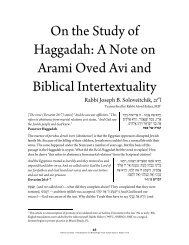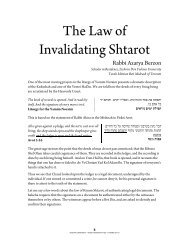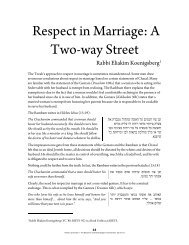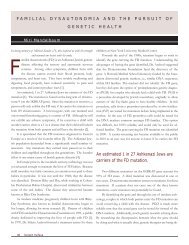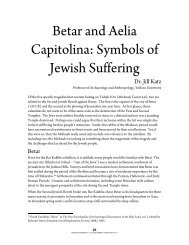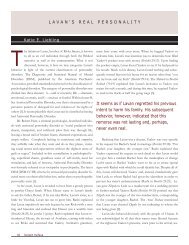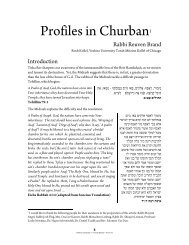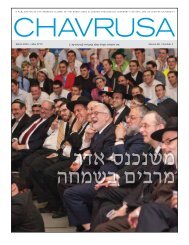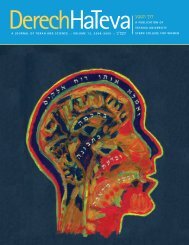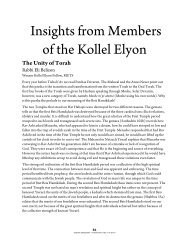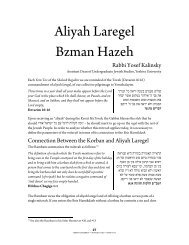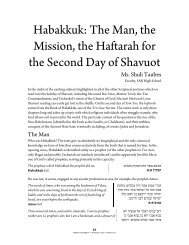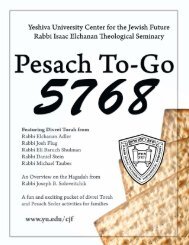YESHIVA UNIVERSITY • SUKKOT TO-GO ... - YU Torah Online
YESHIVA UNIVERSITY • SUKKOT TO-GO ... - YU Torah Online
YESHIVA UNIVERSITY • SUKKOT TO-GO ... - YU Torah Online
Create successful ePaper yourself
Turn your PDF publications into a flip-book with our unique Google optimized e-Paper software.
Sukkos: Harbinger of the Messianic Era<br />
Sukkos carries within it the theme of Jewish unity because, like Yom Kippur, it is representative<br />
of the oneness of G-d. Sukkos is replete with eschatological undertones, as evident, for example,<br />
in the first day’s haftara reading from the Prophet Zechariah, depicting the Messianic war of Gog<br />
u’Magog. While many of the finer details of the narrative remain shrouded in mystery, the<br />
outcome of the battle is unambiguous:<br />
Hashem will be the King over all the land; on that day<br />
Hashem will be One and His Name will be One<br />
Zechariah 14:9<br />
8<br />
<strong>YESHIVA</strong> <strong>UNIVERSITY</strong> <strong>•</strong> <strong>SUKKOT</strong> <strong>TO</strong>-<strong>GO</strong> <strong>•</strong> TISHREI 5771<br />
היהי אוהה םויב ץראה לכ לע ךלמל 'ה<br />
היהו<br />
דחא ומשו דחא 'ה<br />
ט,<br />
די הירכז<br />
The sifrei kabbalah explain that the offering of 70 bullocks, in decreasing order, during the seven<br />
days of Sukkos, is symbolic of the ultimate triumph of good over evil (as symbolized by the 70<br />
nations), and the subsequent revelation of G-d’s Majesty in all of Its glory. Furthermore, it is<br />
explained that the unbridled sense of joy associated with the festival of Sukkos foreshadows the<br />
experience of “az yimalei sechok pinu” (Tehillim 126:2) – a state of ecstasy characteristic of the<br />
Messianic age (see Avoda Zara 3b).<br />
Vayakhel Moshe: Fusing Yom Kippur and Sukkos<br />
Perhaps there is an allusion in the <strong>Torah</strong> to this commonality of Yom Kippur and Sukkos. The<br />
opening verse in Parshas VaYakhel states:<br />
Moshe assembled the entire assembly of the children of Israel<br />
Shemos 35:1<br />
לארשי ינב תדע לכ תא השמ להקיו<br />
א,<br />
הל תומש<br />
The central purpose of this grand assembly was an appeal for materials needed for constructing<br />
the mishkan. (Indeed, the parsha goes on to describe the generous spirit in which the<br />
contributions were brought in the subsequent days.) Rashi notes the timing of this assembly:<br />
Motza’ai Yom HaKipurim - the morrow of Yom Kippur (when Moshe had descended with the<br />
second set of luchos). The Vilna Gaon explains that we celebrate Sukkos in Tishrei, rather than in<br />
Nisan, to commemorate the return of the ananei ha’kavod – pillars of glory - which departed as a<br />
result of the chet ha’eigel. Their restoration, according to the Vilna Gaon, coincided with the<br />
onset of construction of the mishkan, which was the fifteenth of Tishrei, a few days after Moshe’s<br />
appeal. In light of what we have seen, it is most apropos that the mass assembly of “Vayakhel<br />
Moshe” (“And Moshe gathered”) coincided with the morrow of Yom Kippur, the first of the days<br />
bridging Yom Kippur and Sukkos. It was none other than Moshe Rabbeinu who imbued these<br />
days with the spirit of Jewish unity that subsequently became their hallmark.<br />
Moreover, the first lesson taught by Moshe Rabbeinu at that historic assembly was the mitzvah of<br />
Shabbos, a weekly reminder of “Yom shekulo Shabbos” – the eschatological Sabbath where G-d<br />
will reign supreme in unparalleled glory. Next, Moshe singled out one of the 39 categories of<br />
prohibited labor – kindling a fire:<br />
You shall not kindle fire in any of your dwellings<br />
on the Sabbath day.<br />
תבשה םויב םכיתובשומ לכב שא ורעבת אל



